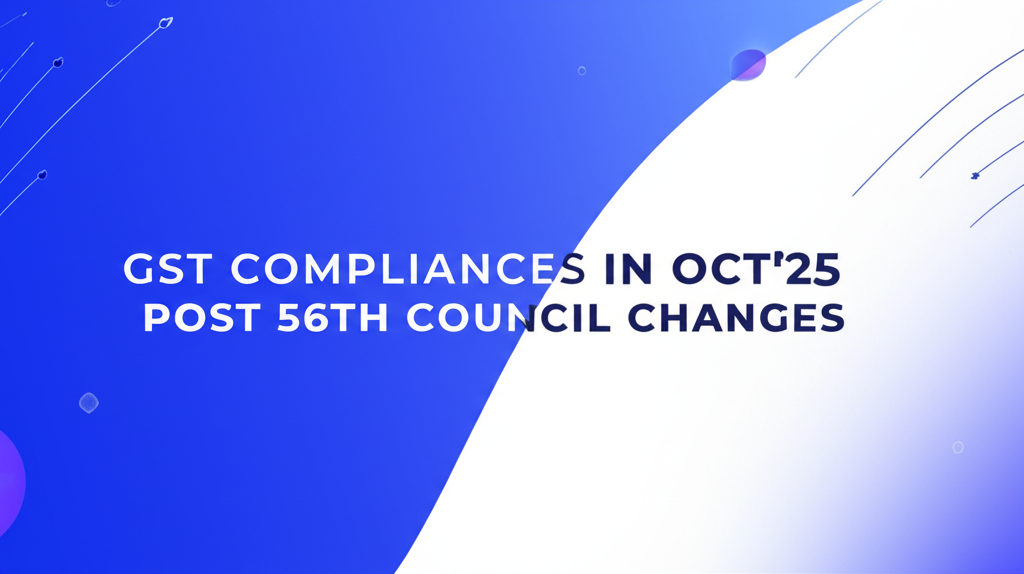Here’s a rundown of key GST-compliance changes and “watch-outs” from October 2025 in light of the 56th GST Council meeting and related notifications. These are important for taxpayers (suppliers, purchasers, platform operators, etc.) to keep in mind. If you want a calendar view for your business type, I can prepare that too.
Major Reform Changes from the 56th GST Council & Their Impact
Before jumping into October 2025, a few major changes from the 56th GST Council (3 September 2025) and related CBIC notifications set the context:
-
The Council approved a “Next-Generation GST” reform, including rate rationalisation (removal of 12% and 28% slabs, merging many items into 5% or 18%), special “demerit” 40% rate for sin/luxury goods, and exemptions (e.g. life & health insurance) in some cases.
-
The new rates and changes mostly come into effect from 22 September 2025 (for goods and services) except for certain goods (like tobacco, etc.) where existing rates continue until compensation obligations are fulfilled.
-
The Finance Act, 2025 brought certain amendments to the CGST Act which are to be effective from 1 October 2025.
-
Also, CBIC / GSTN has issued advisories around changes in the Invoice Management System (IMS) and clarifications that auto-population of ITC from GSTR-2B → GSTR-3B remains, despite IMS.
So October 2025 is a transition phase: new statutory changes will start applying, while taxpayers must reconcile old and new rules carefully.
Important GST Compliances / Changes in October 2025
Here are the key compliance items, obligations, and issues to watch in October 2025 under the new regime:
| Compliance Item / Change | Effective Date / Time | What Has Changed / What to Watch | Practical Steps / Risks |
|---|---|---|---|
| Implementation of statutory amendments from Finance Act 2025 / CGST Act changes | 1 October 2025 | Some new provisions in CGST as amended under the Finance Act will become operative. | Review the amendments (e.g. changes in credit note treatment, appeal rules, etc.), update internal compliance checklists, train tax / accounting teams |
| New GST rate structure / applicability | 22 September 2025 (already in effect by October) | Many goods and services have moved rate slabs. Some goods (tobacco, etc.) remain under old rates until compensation liabilities are cleared. | Update your billing / ERP systems, make sure pricing & tax codes are aligned to the new rates, communicate changes to customers / vendors |
| Invoice Management System (IMS) launch / changes | October 2025 (or around) | GSTN clarified that auto-population of ITC from GSTR-2B to GSTR-3B stays the same (no change) despite IMS. | Be cautious of misinformation about ITC changes; ensure that invoices are uploaded / matched timely and review IMS features (regenerate GSTR-2B if needed) |
| Waiver of GSTR-9 / 9A annual return for small taxpayers (turnover ≤ ₹2 crore) | From FY 2024–25 onwards (notification effective Oct 1) | Taxpayers whose aggregate turnover does not exceed ₹2 crore need not file GSTR-9 / 9A for FY 2024–25 and subsequent years. | If turnover is ≤ ₹2 cr, check if you qualify for the waiver; adjust your compliance calendar accordingly |
| GST Return / Filing Due Dates (October 2025 month-wise) | As per usual monthly/quarterly calendar | Typical periodic returns like GSTR-1, GSTR-3B, GSTR-7, GSTR-8 etc. remain due. | Ensure timely filing and payment under new rates for September / October periods. (See below for dates) |
| Post-Sales Discount / Credit Note reporting simplification | Circular (1 October 2025) | A new circular permits suppliers to pass post-sales discounts via GST credit notes more flexibly, without needing pre-signed agreements or invoice-wise linkage. Recipient must reverse proportionate ITC. | Revise discount documentation / contract templates; ensure credit notes are issued and recipients reverse ITC proportionately |
| HSN / SAC Code changes / reclassification | With GST 2.0 rollout | There is a revision / rationalisation in HSN / SAC codes under the new regime. | Review product / service classification codes with your tax / product teams; ensure correct classification in invoices and returns |
| Refund / Export claims and restrictions | Some notifications post-Council meeting | For example, Notification No. 14/2025-CT excludes certain players (areca nut, pan masala, tobacco, essential oils) from provisional 90% refund. Also, supply from SEZ / FTWZ to DTA / before export clearance is not to be treated as supply (retrospectively) from 1 July 2017 (as per a CBIC/GST alert) | If you are in sectors excluded from provisional refund, plan cash flows accordingly; review SEZ/FTWZ arrangements and ensure compliance with retrospective supply definitions |
| Segregation of new vs old regime in transitional period | During transition months (Oct / Nov) | You may have supplies under old rates and new rates in the same period (especially for inventory carry-forwards) | Maintain separate tracking of supplies taxed under old vs new rates; document transitional stock, credit, and invoices carefully |
| System / ERP / Billing updates | Immediately going into October | All billing, accounting, ERP systems must reflect new slab rates, HSN/SAC mappings, discount rules | Work with IT / software vendors to patch changes before October 22, test thoroughly for invoice generation / returns |
| Awareness & communication | Ongoing | Many stakeholders—vendors, customers, accountants—need to be sensitised to new rates, new procedures, IMS, etc. | Prepare communication memos / training sessions, issue rate change notices to clients / contractual amendments if needed |
GST Due Dates in October 2025 (Usual / Periodic Compliance)
Here’s a quick snapshot of key GST return due dates in October 2025 (for the September 2025 period), to make sure you don’t miss routine compliance:
| Date | Return/Form | Applicable To |
|---|---|---|
| 10 October 2025 | GSTR-7 | Persons required to deduct TDS under GST |
| 10 October 2025 | GSTR-8 | E-commerce operators (TCS) |
| 11 October 2025 | GSTR-1 (monthly) | Taxpayers filing monthly returns |
| 13 October 2025 | GSTR-5 | Non-resident taxable persons |
| 13 October 2025 | GSTR-6 | Input Service Distributors (ISD) |
| 18 October 2025 | CMP-08 | Composition scheme taxpayers for quarter July–September 2025 |
| 20 October 2025 | GSTR-3B | Regular taxpayers in monthly mode (turnover above ₹5 cr) |
| 22 October 2025 | GSTR-3B (Quarterly) | Taxpayers under QRMP scheme for July–September |
These are the standard deadlines; keep an eye for any extensions or notifications from your state or central authorities.
Strategic Recommendations & Risk Areas
-
Dual regime overlap: During transition (October onward), supplies may straddle old and new rates. Incorrect classification or rate usage may lead to notices.
-
ITC matching / reconciliation: Although ITC auto-population remains, mismatches due to new discount / credit note rules or HSN reclassification may creep in. Maintain tight vendor coordination.
-
Refund cash flow planning: Particularly for export-oriented units, sectors not eligible for provisional 90% refund should plan extra liquidity.
-
System readiness: Any delay in patching your billing / ERP systems might cause invoice / return errors or liability in interest / penalties.
-
Training & awareness: Lots of moving parts — ensure accounting / tax staff, sales teams, procurement teams are thoroughly briefed on the changes.
-
Document transitional stock / carry-forwards: Maintain robust audit trails so that any tax authority queries can be addressed.


